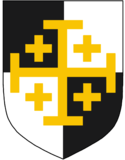National Catholicism
| Part of a series on |
| Romerism |
|---|
 |
| Categories: |
National Catholicism (Creeperian – Creeperian: Նածիոնալծատօլիծիսմո; Creeperian – Iberic: Nacionalcatólicismo; Creeperian pronunciation: [na.si.oˈnal.ka.to.liˈsis.mo]), sometimes abbreviated NaCatól (ՆաԾատօլ), is a Creeperian government policy, political ideology, and core tenant of Romerism which places an emphasis of importance on the role of the Creeperian Catholic Church and the Creeperian Catholic religion in Creeperian society, culture, and politics. Additionally, the ideology recognizes the Creeperian Catholic religion as the official religion of Creeperopolis over other religions such as Protestantism, Islam, and irreligiousness.
The ideology first began to manifest during the Adolfisto period between 1833 and 1887 during the absolute reign of Emperor Adolfo III through his policies of protecting the status of the Church and implementing the teachings of the Church into the national laws of the country. National Catholicism as a distinct political ideology manifested during the Second Parliamentary Era of Creeperopolis between 1887 and 1933 when the nation's government was democratically election by the citizenry. The right-wing Catholic Royalist Party (PRC) and the far-right Creeperian Pro-Fatherland Front (FPPC) both possessed pro-Catholic and anti-secular agendas, both advocating for the reinstatement of Creeperian Catholicism as the national religion of Creeperopolis. During the Creeperian Civil War, the right-wing Catholic Imperial Restoration Council (CRIC) adopted the ideology, and as a result, it became a core tenant of Romerism, the political ideology formed by the council. The ideology was adopted as an official ideology by the Creeperian Initiative (IC), the sole legal political party in Creeperopolis, when it was founded on 4 October 1949.
National Catholicism is a form of political Creeperian Catholicism, which is most visible in the hegemony that the Creeperian Catholic Church has in Creeperian politics. Catholicism has historically been deeply rooted into Creeperian culture and society, and the government policy of National Catholicism reinforces centuries of Catholic tradition in Creeperopolis. The Creeperian government has funded several projects on behalf of the Creeperian Catholic Church, and simultaneously, has oppressed religious minorities within the country, especially Protestants, Muslims, and the irreligious as a result of the National Catholic policies.
Contents
Name

National Catholicism was first coined on 15 September 1903 by Prime Minister Antonio Sáenz Heredia during a speech on the Day of the Creeperans, a national holiday in Creeperopolis. During the speech, he stated:
The Fatherland was built upon the foundation of the Catholic faith, and without that faith, Creeperopolis is nothing, and the Creeperans are better off struck down by God Himself than if they continued living without having faith in God Almighty. Catholicism across the national, a National Catholicism, rooted in the very laws and constitution of the Fatherland, is necessary to maintain the continued existence of the Fatherland. A secular Creeperopolis is a Creeperopolis of Baphomet,[note 1] but a Catholic Creeperopolis is a Creeperopolis of God and eternal continuity.
— Antonio José Sáenz Heredia, 15 September 1903[1]
As defined by the Imperial Academy of the Creeperian Language, supporters of National Catholicism are known as National Catholics (Նածիոնալծատօլիծոս; Nacionalcatólicos), and reference to the ideology as an adjective is National Catholic (Նածիոնալծատօլիծո; Nacionalcatólico).[2] National Catholicism can also be abbreviated as NaCatól (ՆաԾատօլ), but the usage of the abbreviation is rare from official government sources.[2] Opponents and critics of the ideology sometimes refer to it as National Theism, a term opposed by the Creeperian government as the government claims that "theism" implies and means that all religions are included in the policy, instead of just Creeperian Catholicism.[3]
Definitions
Historians and scholars, as well as politicians, have almost unanimously agreed upon a set criteria for laws and policies which qualify as being "National Catholic." The criteria includes:[4][5]
- Supports further influence of the Creeperian Catholic Church
- Implements Creeperian Catholic teachings into laws and policies
- Attacks other religions in defense of Creeperian Catholicism
Position in the political spectrum
The Creeperian government officially states that National Catholicism is a right-wing ideology on the traditional political spectrum,[4] however, some foreign organizations and political critics consider the ideology to be on the far-right. The ideology has been described as an "extremist right form of forced religion on a nation."[6]
History
Proto-National Catholicism
During the reign of Emperor Adolfo III (reigned 14 June 1833 – 1 December 1887), the Creeperian government implemented laws and issued decrees which supported and increased the role of the Creeperian Catholic Church in many aspects of Creeperian government, culture, and society.[7] The first such laws were implemented on 1 April 1839; the Decree for Catholicism in Senvar, known abroad the Anti-Protestant Decree, mandated the supremacy of the Creeperian Catholic faith over Senvarian Protestantism in the Creeperian departments of Senvar and Sonsatepan after the annexation of the Kingdom of Senvar the month prior.[8][9] Religious animosity between Creeperans and Senvarians helped contribute to the violence of the First Senvarian Insurgency, and despite the Creeperian military victory in 1957, the Creeperian government amended the decree to be less restrictive on Senvarian Protestantism as a part of the Treaty of Tuxtla Martínez.[10][11]
In December 1845, Adolfo III drafted and adopted a new constitution, abolishing the constitution drafted by his grandfather, Manuel III, in 1778.[12] The new constitution was the first to officially recognize the Creeperian Catholic faith as the national religion of Creeperopolis and set several exemptions for the Creeperian Catholic Church, most notably exempting the Church from taxation.[13][note 2] The constitution has been described by historians as the first National Catholic nationwide law implemented in Creeperopolis.[13]
Evolution during the Second Parliamentary Era

Modern institution
Tenants
Theocracy
Anti-Atheism and Anti-Islamism
Social conservatism
Nationalism
Criticism
Notable National Catholic laws and policies
- Adolfisto
- Second Parliamentary Era
- Modern Creeperopolis
Political parties with National Catholicism as an ideology
- Italics indicates faction and/or minor ideology.
- Active
 Creeperian Initiative (IC)
Creeperian Initiative (IC) Creeperian League (LICRE)
Creeperian League (LICRE) Salvadoran Initiative (IS)
Salvadoran Initiative (IS)
- Defunct
 Castillianan Coalition of Autonomous Rights (CCDA)
Castillianan Coalition of Autonomous Rights (CCDA) Catholic Royalist Party (PRC)
Catholic Royalist Party (PRC) Creeperian Pro-Fatherland Front (FPPC)
Creeperian Pro-Fatherland Front (FPPC) National Action Party (PAN)
National Action Party (PAN) National Conservative Party (PCN)
National Conservative Party (PCN) Salvadoran Nationalist Party (PSN)
Salvadoran Nationalist Party (PSN) Salvadoran Pro-Fatherland Front (FSPP)
Salvadoran Pro-Fatherland Front (FSPP)
National Catholic theorists
The following individuals are officially listed by the Creeperian government as "National Catholic theorists and founders":[4]
- Monarchs
- Adolfo III, Emperor (1833–1887)
- Adolfo IV, Emperor (1918–1933)
- Alexander I, Emperor (1898–1910)
- Alfonso V, Emperor (1910–1918)
- Romero I, Emperor (1933–1946)
- Romero II, Emperor (1946–1976)
- Politicians
- Julio Alda Miqueleiz – Triumvir of the Catholic Royalist Party (1902–1936)
- Alfonso García Valdecasas – Triumvir of the Catholic Royalist Party (1902–1936)
- Carlos Hernández Videla – Leader of the Romerist Nationalist Front (1963–1975), Leader of the Creeperian Pro-Fatherland Front (1921–1949), Leader of the Creeperian Fascist Union (1920–1921), Leader of the League of Creeperian Fascists (1919–1920)
- Máximo Illescas Freixa – Chief Mayor (1949–1965), Prime Minister (1933–1949), Leader of the National Conservative Party (1928–1949)
- Adolfo Rivera López – Leader of the Militarist Nationalist Front (1940–1981)
- Antonio Sáenz Heredia – Secretary of the Creeperian Initiative (1949–1957), Duumvir of the Catholic Royalist Party (1936–1949), Mayor of Nuevo Xichútepa (1933–1957), Prime Minister (1902–1907, 1912–1917, 1922–1927, 1928), Triumvir of the Catholic Royalist Party (1902–1936), Leader of the Catholic Royalist Party (1901–1949)
- Ramón Serrano Suñer – Duumvir of the Catholic Royalist Party (1936–1949), Mayor of Nuevo Xichútepa (1936), Mayor of Citalá (1922–1999)
- Military leaders
- Adolfo Cabañeras Moreno – Minister of Defense (1931–1944), Minister of Intelligence (1933–1944)
- Alfonso Cabañeras Moreno – Minister of Defense (1944–1976), Minister of Intelligence (1944–1976)
- Enrique Figueroa Guerrero – Leader of the Crusaders of King Alfonso (1933–1940)
- Juan Primavera Sánchez – Field Marshal of the Army Group Miguel I (1946–1949)
- Alexander Sánchez Molina – Leader of the Crusaders of King Alfonso (1940–1949)
- Leónidas Trujillo Molina – Chief Admiral (1948–1955)
- Óscar Únzaga Vega – Chief Guard (1951–1959), Captain of the Falange Creeperiano (1902–1949)
- José Ureña Estrella – Chief Admiral (1922–1927, 1933–1948)
See also
- Similar policies
- Similar ideologies
Notes
- ↑ In Creeperopolis, the Islamic prophet Muhammad is erroneously referred to as the demon Baphomet, originally due to a mistranslation of an ancient Islamic text into Xichútepan, but has since evolved to deliberate disrespectful terminology in modern Creeperopolis.
- ↑ Prior to the adoption of the fourth constitution, the Church was not taxed from 1778. The fourth constitution only made the Church's tax exemption status written into national law, as it had already been tax exempted.
References
Citations
- ↑ Pareja Palau 1998, pp. 598–599.
- ↑ 2.0 2.1 "Նածիոնալծատօլիծիսմո" [National Catholicism]. aiiec.gob.cr (in Creeperian). Imperial Academy of the Creeperian Language. 2003. Retrieved 14 November 2021.CS1 maint: unrecognized language (link)
- ↑ Pareja Palau 1998, p. 611.
- ↑ 4.0 4.1 4.2 Ramírez Ortega 2006, pp. 23–24.
- ↑ Pareja Palau 1998, p. 597.
- ↑ Hernández Alvarado, Orlando Édgar (7 March 2011). "لى فىنتىسـِيـَا دىل نىسـِيـُونىلقىتـُولـِيسـِيسمـُو" [The Fantasy of National Catholicism]. elfaro.net.sc (in Andaluzian Spanish). El Faro. Retrieved 15 November 2021.CS1 maint: unrecognized language (link)
- ↑ Pareja Palau 1998, p. 545.
- ↑ 8.0 8.1 Pareja Palau 1998, pp. 545–546.
- ↑ 9.0 9.1 Pareja Palau 2018, p. 303.
- ↑ Pareja Palau 1998, p. 548.
- ↑ Pareja Palau 2018, p. 310.
- ↑ 12.0 12.1 Pareja Palau 2018, p. 320.
- ↑ 13.0 13.1 13.2 Pareja Palau 1998, p. 560.
- ↑ Pareja Palau 1998, p. 700.
- ↑ Pareja Palau 1998, p. 1032.
Bibliography
- Pareja Palau, Orlando Óscar (1 September 1998). Written at Nuevo Xichútepa, Creeperopolis. Հիստորիա դե Ծատօլիծիսմո [History of Catholicism]. History of the Fatherland (in Creeperian). II (1 ed.). San Salvador, Creeperopolis: Impresión Creeperiano (published 25 December 1998). ISBN 0-7864-0612-7. Retrieved 14 November 2021.CS1 maint: unrecognized language (link)
- Pareja Palau, Orlando Óscar (1 September 2018). Written at Nuevo Xichútepa, Creeperopolis. Լոս'Սենվարիանոս [The Senvarians]. History of the Fatherland (in Creeperian). I (2 ed.). San Salvador, Creeperopolis: Impresión Creeperiano. ISBN 978-0802862341. Retrieved 18 November 2021.CS1 maint: unrecognized language (link)
- Ramírez Ortega, Alexander Gustavo (15 September 2006). Իդեոլոգիաս դե լա'Պատրիա [Ideologies of the Fatherland] (in Creeperian). I (1 ed.). San Salvador, Creeperopolis: Ministry of Internal Affairs. ISBN 978-0-299-09804-9. Retrieved 14 November 2021.CS1 maint: unrecognized language (link)
Further reading
- Pareja Palau, Orlando Óscar (1 May 2009). Written at Nuevo Xichútepa, Creeperopolis. Գփերրա Ծիվիլ [Civil War]. History of the Fatherland (in Creeperian). I (2 ed.). San Salvador, Creeperopolis: Impresión Creeperiano. ISBN 978-0-8330-4159-3. Retrieved 14 November 2021.CS1 maint: unrecognized language (link)

